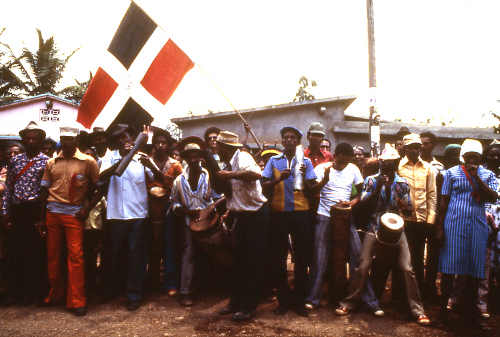Blog February 18, 2015
The Music of Trance: A Primer
Over the years, we have touched on the music and cultures featured in our recent Hip Deep program The Nature of Trance.
Haitian Vodou
 Haitian vodou is a complex, syncretic spiritual system derived from West African vodun, a form of spirit and ancestor worship spanning Benin, Togo, Ghana and Nigeria. In Haiti, as in West Africa, trance is an essential part of ceremonies, allowing the spirits, called loa, to enter the bodies of dancing practitioners.
Related programs:
Music and the Story of Haiti: From Vodou to Compas to Racine to Rara and Beyond
After the Quake: Music, Politics and Spirituality in Haiti
Featured Artist: Val Jeanty, known as Val-Inc, is a drummer, singer, producer and turntablist who makes live Afro-electronic music drawing on Haitian vodou music. Raised in Haiti, she became involved at an early age in sacred trance music performance, and brings elements of this performance experience into the club environment.
Tarab
Haitian vodou is a complex, syncretic spiritual system derived from West African vodun, a form of spirit and ancestor worship spanning Benin, Togo, Ghana and Nigeria. In Haiti, as in West Africa, trance is an essential part of ceremonies, allowing the spirits, called loa, to enter the bodies of dancing practitioners.
Related programs:
Music and the Story of Haiti: From Vodou to Compas to Racine to Rara and Beyond
After the Quake: Music, Politics and Spirituality in Haiti
Featured Artist: Val Jeanty, known as Val-Inc, is a drummer, singer, producer and turntablist who makes live Afro-electronic music drawing on Haitian vodou music. Raised in Haiti, she became involved at an early age in sacred trance music performance, and brings elements of this performance experience into the club environment.
Tarab
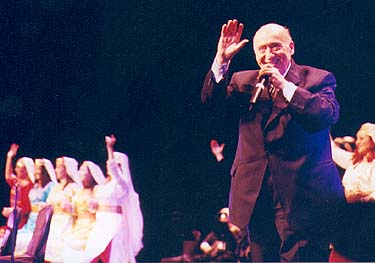 The word tarab means "ecstasy," and this style of music is known to induce ecstasy in performers and listeners alike across the Arab world. When all the elements of the music align perfectly, musicians and audience can achieve saltana, a mystical state of trance. Scholar and musician A.J. Racy guides us through the working of tarab specifically in Egypt and Syria.
Related programs:
Tarab: The Art of Ecstasy in Arab Music
Morocco and Gnawa
The word tarab means "ecstasy," and this style of music is known to induce ecstasy in performers and listeners alike across the Arab world. When all the elements of the music align perfectly, musicians and audience can achieve saltana, a mystical state of trance. Scholar and musician A.J. Racy guides us through the working of tarab specifically in Egypt and Syria.
Related programs:
Tarab: The Art of Ecstasy in Arab Music
Morocco and Gnawa
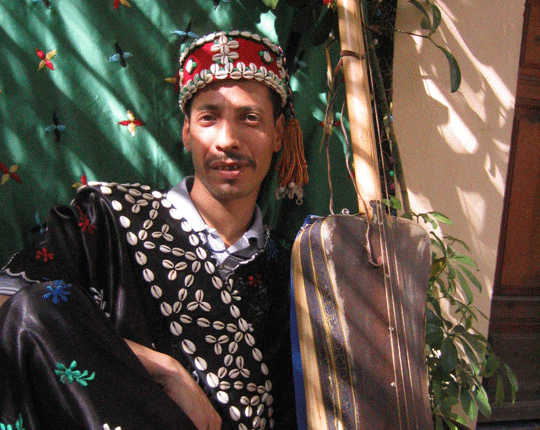 According to scholar Deborah Kapchan, trance has become "the signature aesthetic of Moroccan music," from popular music to traditional Gnawa music. Gnawa is a spiritual Islamic brotherhood with roots in pre-Islamic sub-Saharan Africa. Their hypnotic music, using the three-stringed bass, guimbri, animates nighttime ceremonies for healing the sick, where spirits possess trancing dancers.
Related programs:
Traveling Spirit Masters
African Slaves in Islamic Lands
Zimbabwe: Shona Mbira
According to scholar Deborah Kapchan, trance has become "the signature aesthetic of Moroccan music," from popular music to traditional Gnawa music. Gnawa is a spiritual Islamic brotherhood with roots in pre-Islamic sub-Saharan Africa. Their hypnotic music, using the three-stringed bass, guimbri, animates nighttime ceremonies for healing the sick, where spirits possess trancing dancers.
Related programs:
Traveling Spirit Masters
African Slaves in Islamic Lands
Zimbabwe: Shona Mbira
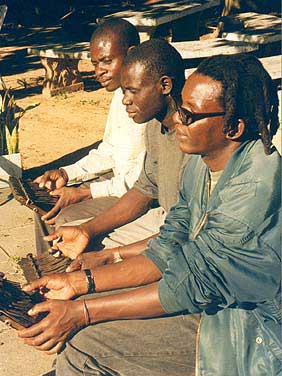 Among the Shona people of Zimbabwe, the mbira dzavuzimu is used in ceremonies known as bira, sometimes for healing, but also for giving thanks, honoring the deceased, praying for rain or for calling departed ancestors. The music induces spirit possession in specially chosen spirit mediums, often elders, who receive the spirit of an ancestor and then advise the attending people.
Related programs:
The Art of Improvisation 2
Brazil: Candomblé
In Brazil, enslaved Africans transformed West African forms of spirit worship into candomblé, a syncretic religion venerating spirits known as orixas, basically Yoruba deities combined and aligned with Catholic saints. Ceremonies include drumming, singing, dancing and spirit possession through trance.
Related programs:
Rio 1: Samba at the Dawn of Modern Brazil
Samba, Forro, Candomble, Tropicalia: The Sounds of Brazilian Artists in the U.S.
Cuba: Santeria, Palo, Arará
Among the Shona people of Zimbabwe, the mbira dzavuzimu is used in ceremonies known as bira, sometimes for healing, but also for giving thanks, honoring the deceased, praying for rain or for calling departed ancestors. The music induces spirit possession in specially chosen spirit mediums, often elders, who receive the spirit of an ancestor and then advise the attending people.
Related programs:
The Art of Improvisation 2
Brazil: Candomblé
In Brazil, enslaved Africans transformed West African forms of spirit worship into candomblé, a syncretic religion venerating spirits known as orixas, basically Yoruba deities combined and aligned with Catholic saints. Ceremonies include drumming, singing, dancing and spirit possession through trance.
Related programs:
Rio 1: Samba at the Dawn of Modern Brazil
Samba, Forro, Candomble, Tropicalia: The Sounds of Brazilian Artists in the U.S.
Cuba: Santeria, Palo, Arará
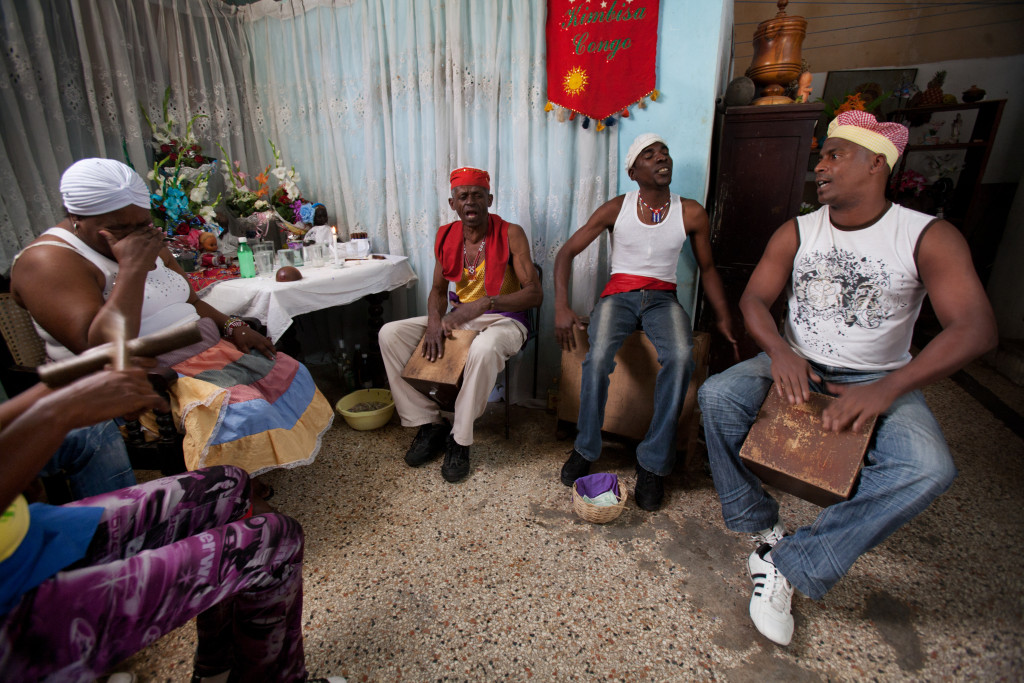 Similarly, in Cuba, enslaved Africans transformed West and Central African forms of spirit worship into santeria, a syncretic religion venerating spirits known as orishas, basically Yoruba deities combined and aligned with Catholic saints. In Cuba there are also musical and spiritual practices and deities from the region of Congo and Benin, known as palo monte and arará respectively.
Related programs:
The Cuban Connection
The Cuban Connection 2
Other Related Programs:
Benin: Transforming Traditions
Afro-Dominicana: The Other Domincan Republic
Similarly, in Cuba, enslaved Africans transformed West and Central African forms of spirit worship into santeria, a syncretic religion venerating spirits known as orishas, basically Yoruba deities combined and aligned with Catholic saints. In Cuba there are also musical and spiritual practices and deities from the region of Congo and Benin, known as palo monte and arará respectively.
Related programs:
The Cuban Connection
The Cuban Connection 2
Other Related Programs:
Benin: Transforming Traditions
Afro-Dominicana: The Other Domincan Republic
 Haitian vodou is a complex, syncretic spiritual system derived from West African vodun, a form of spirit and ancestor worship spanning Benin, Togo, Ghana and Nigeria. In Haiti, as in West Africa, trance is an essential part of ceremonies, allowing the spirits, called loa, to enter the bodies of dancing practitioners.
Related programs:
Music and the Story of Haiti: From Vodou to Compas to Racine to Rara and Beyond
After the Quake: Music, Politics and Spirituality in Haiti
Featured Artist: Val Jeanty, known as Val-Inc, is a drummer, singer, producer and turntablist who makes live Afro-electronic music drawing on Haitian vodou music. Raised in Haiti, she became involved at an early age in sacred trance music performance, and brings elements of this performance experience into the club environment.
Tarab
Haitian vodou is a complex, syncretic spiritual system derived from West African vodun, a form of spirit and ancestor worship spanning Benin, Togo, Ghana and Nigeria. In Haiti, as in West Africa, trance is an essential part of ceremonies, allowing the spirits, called loa, to enter the bodies of dancing practitioners.
Related programs:
Music and the Story of Haiti: From Vodou to Compas to Racine to Rara and Beyond
After the Quake: Music, Politics and Spirituality in Haiti
Featured Artist: Val Jeanty, known as Val-Inc, is a drummer, singer, producer and turntablist who makes live Afro-electronic music drawing on Haitian vodou music. Raised in Haiti, she became involved at an early age in sacred trance music performance, and brings elements of this performance experience into the club environment.
Tarab
 The word tarab means "ecstasy," and this style of music is known to induce ecstasy in performers and listeners alike across the Arab world. When all the elements of the music align perfectly, musicians and audience can achieve saltana, a mystical state of trance. Scholar and musician A.J. Racy guides us through the working of tarab specifically in Egypt and Syria.
Related programs:
Tarab: The Art of Ecstasy in Arab Music
Morocco and Gnawa
The word tarab means "ecstasy," and this style of music is known to induce ecstasy in performers and listeners alike across the Arab world. When all the elements of the music align perfectly, musicians and audience can achieve saltana, a mystical state of trance. Scholar and musician A.J. Racy guides us through the working of tarab specifically in Egypt and Syria.
Related programs:
Tarab: The Art of Ecstasy in Arab Music
Morocco and Gnawa
 According to scholar Deborah Kapchan, trance has become "the signature aesthetic of Moroccan music," from popular music to traditional Gnawa music. Gnawa is a spiritual Islamic brotherhood with roots in pre-Islamic sub-Saharan Africa. Their hypnotic music, using the three-stringed bass, guimbri, animates nighttime ceremonies for healing the sick, where spirits possess trancing dancers.
Related programs:
Traveling Spirit Masters
African Slaves in Islamic Lands
Zimbabwe: Shona Mbira
According to scholar Deborah Kapchan, trance has become "the signature aesthetic of Moroccan music," from popular music to traditional Gnawa music. Gnawa is a spiritual Islamic brotherhood with roots in pre-Islamic sub-Saharan Africa. Their hypnotic music, using the three-stringed bass, guimbri, animates nighttime ceremonies for healing the sick, where spirits possess trancing dancers.
Related programs:
Traveling Spirit Masters
African Slaves in Islamic Lands
Zimbabwe: Shona Mbira
 Among the Shona people of Zimbabwe, the mbira dzavuzimu is used in ceremonies known as bira, sometimes for healing, but also for giving thanks, honoring the deceased, praying for rain or for calling departed ancestors. The music induces spirit possession in specially chosen spirit mediums, often elders, who receive the spirit of an ancestor and then advise the attending people.
Related programs:
The Art of Improvisation 2
Brazil: Candomblé
In Brazil, enslaved Africans transformed West African forms of spirit worship into candomblé, a syncretic religion venerating spirits known as orixas, basically Yoruba deities combined and aligned with Catholic saints. Ceremonies include drumming, singing, dancing and spirit possession through trance.
Related programs:
Rio 1: Samba at the Dawn of Modern Brazil
Samba, Forro, Candomble, Tropicalia: The Sounds of Brazilian Artists in the U.S.
Cuba: Santeria, Palo, Arará
Among the Shona people of Zimbabwe, the mbira dzavuzimu is used in ceremonies known as bira, sometimes for healing, but also for giving thanks, honoring the deceased, praying for rain or for calling departed ancestors. The music induces spirit possession in specially chosen spirit mediums, often elders, who receive the spirit of an ancestor and then advise the attending people.
Related programs:
The Art of Improvisation 2
Brazil: Candomblé
In Brazil, enslaved Africans transformed West African forms of spirit worship into candomblé, a syncretic religion venerating spirits known as orixas, basically Yoruba deities combined and aligned with Catholic saints. Ceremonies include drumming, singing, dancing and spirit possession through trance.
Related programs:
Rio 1: Samba at the Dawn of Modern Brazil
Samba, Forro, Candomble, Tropicalia: The Sounds of Brazilian Artists in the U.S.
Cuba: Santeria, Palo, Arará
 Similarly, in Cuba, enslaved Africans transformed West and Central African forms of spirit worship into santeria, a syncretic religion venerating spirits known as orishas, basically Yoruba deities combined and aligned with Catholic saints. In Cuba there are also musical and spiritual practices and deities from the region of Congo and Benin, known as palo monte and arará respectively.
Related programs:
The Cuban Connection
The Cuban Connection 2
Other Related Programs:
Benin: Transforming Traditions
Afro-Dominicana: The Other Domincan Republic
Similarly, in Cuba, enslaved Africans transformed West and Central African forms of spirit worship into santeria, a syncretic religion venerating spirits known as orishas, basically Yoruba deities combined and aligned with Catholic saints. In Cuba there are also musical and spiritual practices and deities from the region of Congo and Benin, known as palo monte and arará respectively.
Related programs:
The Cuban Connection
The Cuban Connection 2
Other Related Programs:
Benin: Transforming Traditions
Afro-Dominicana: The Other Domincan Republic







